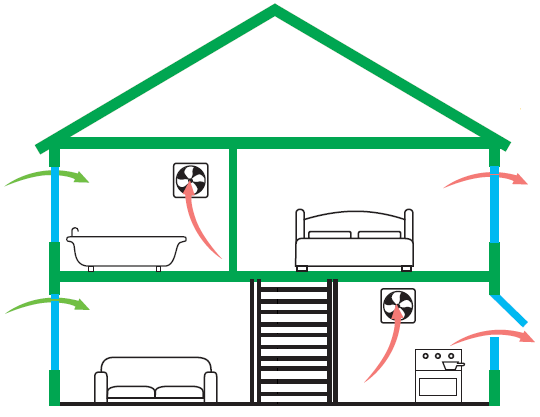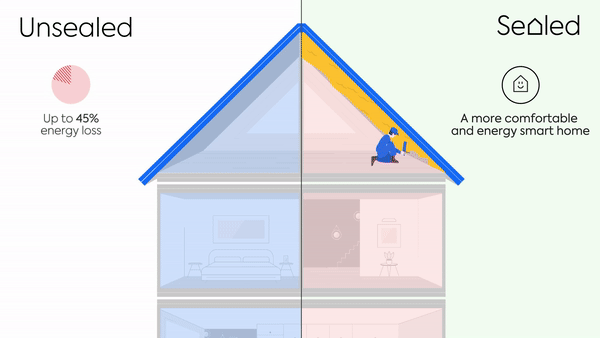Home Ventilation Melbourne Safety Tips for Cleaner Indoor Air
Wiki Article
Comprehending the Importance of Home Air Flow for a Healthier Living Environment
Home ventilation plays a necessary function in maintaining a healthy living environment. It helps with the exchange of indoor and outdoor air, which is very important for improving air quality. Without correct ventilation, homes can become reproducing premises for pollutants and allergens. The repercussions of insufficient air flow can be significant. This raises the inquiry of just how homeowners can successfully apply air flow strategies to safeguard their wellness and wellness. Recognizing these approaches is essential.
The Basics of Home Air Flow
Home air flow acts as a necessary component of indoor air high quality and convenience. It involves the procedure of exchanging stagnant interior air with fresh outside air, thus decreasing moisture and controlling temperature. Correct air flow systems can consist of natural techniques, such as open windows and vents, as well as mechanical systems, such as exhaust fans and air exchangers. Efficient home air flow helps stop concerns like indoor mold growth and the buildup of harmful bits. It likewise boosts overall power effectiveness, as well-ventilated rooms can preserve comfortable temperature levels with much less dependence on heating and cooling systems. Understanding the fundamentals of home air flow is essential for homeowners looking for to develop a much healthier living atmosphere for themselves and their families.
Usual Sources of Indoor Air Air Pollution

Although numerous might not understand it, interior air pollution can originate from numerous resources within a house. Common contributors consist of volatile organic substances (VOCs) discharged from paints, solvents, and cleansing products. Household appliances, such as gas ovens and fire places, can launch dangerous gases like carbon monoxide gas and nitrogen dioxide. In addition, mold and mold thrive in wet locations, launching spores that affect air quality. Pet dander, dust mites, and pollen can collect indoors, additional aggravating air pollution levels. Smoking cigarettes inside produces toxic chemicals that remain airborne. Lastly, building materials, consisting of asbestos and formaldehyde, can off-gas dangerous substances. Acknowledging these resources is essential for preserving a much healthier interior atmosphere and advertising reliable ventilation approaches.
Health Consequences of Poor Air Flow
Indoor air contamination can have considerable health and wellness ramifications, particularly when ventilation is poor. Poor air flow can bring about the accumulation of harmful contaminants, such as unpredictable organic compounds, mold, and particulate issue. This accumulation may lead to breathing concerns, consisting of asthma, allergic reactions, and chronic obstructive lung illness. People might experience signs like headaches, fatigue, and irritability of the eyes, nose, and throat. Susceptible populations, such as children and the senior, go to higher threat for extreme wellness impacts. Lasting exposure to inadequately aerated settings can additionally add to more severe problems, including cardiovascular illness. Ensuring correct ventilation is important for preserving a healthy and balanced living atmosphere and lowering the danger of health complications connected with interior air pollution.Reliable Ventilation Strategies for Your Home
Correct air flow is crucial for keeping a healthy and balanced indoor environment, and executing effective strategies can significantly improve air quality. Property owners can start by guaranteeing that exhaust fans are installed in shower rooms and kitchen areas to remove excess moisture and smells. Opening up home windows on a regular basis enables fresh air to distribute, especially during mild weather. Additionally, utilizing air cleansers with HEPA filters can assist record airborne toxins. For homes with heating and cooling down systems, preserving HVAC systems and altering filters on a regular basis is crucial for peak performance. Including all-natural ventilation strategies, such as cross-ventilation, can also boost air flow. Securing any type of leaks in windows and doors protects against unwanted drafts, which can disrupt regulated airflow, inevitably leading to boosted indoor air high quality and comfort.Maintaining Optimum Air Top Quality Year-Round
To maintain perfect air top quality year-round, homeowners need to adopt an aggressive technique to managing their interior environment. Routinely keeping an eye on indoor air high anonymous quality is essential; this includes monitoring for toxins such as dirt, mold, and unstable organic substances (VOCs) Applying reliable ventilation systems, such as exhaust fans and air purifiers, can substantially reduce airborne pollutants. In addition, regular upkeep of HVAC systems guarantees peak performance and air circulation. Home owners must additionally consider humidity degrees, as excessive wetness can cause mold growth. Seasonal modifications might demand modifications in air flow techniques to accommodate differing outside air quality. By focusing on these methods, house owners can produce a healthier home, advertising general wellness for all residents throughout the year.Frequently Asked Questions
How Can I Tell if My Home Needs Better Ventilation?
To figure out if a home requires better air flow, one ought to observe indications such as relentless humidity, mold and mildew growth, musty smells, condensation on windows, or boosted allergy signs and symptoms, suggesting poor air flow and possibly bad indoor air quality.What Are the Indications of Poor Indoor Air Top Quality?

Can Houseplants Improve Indoor Air High Quality Effectively?
The effectiveness of houseplants in enhancing indoor air quality is disputed. While some researches recommend they can soak up contaminants and produce oxygen, their overall impact might be minimal compared to appropriate air flow and air filtration systems.Exactly how Typically Should I Adjustment My Air Filters?
The regularity of air filter modifications usually relies on use and filter kind. Usually, it is advised to change filters every 3 months, though families with allergic reactions or family you could try here pets may require more frequent changes for suitable performance.Exist Any Particular Air Flow Systems for Allergic Reaction Sufferers?
Numerous air flow systems, such as HEPA-filtered units, successfully decrease allergens in the air. Home Ventilation Melbourne. These systems trap pet dog, pollen, and dirt dander, offering allergy patients with a cleaner, healthier interior environment while handling air top quality properly
It promotes the exchange of outside and indoor air, which is vital for improving air high quality. Home ventilation serves as an essential part of indoor air high quality and convenience. It includes the procedure of exchanging stale indoor air with fresh outside air, thus lowering moisture and managing temperature level. Indoor air contamination can have significant wellness implications, specifically when air flow is poor. Proper ventilation is essential for preserving a healthy interior environment, and implementing reliable approaches can substantially improve air top quality.
Report this wiki page